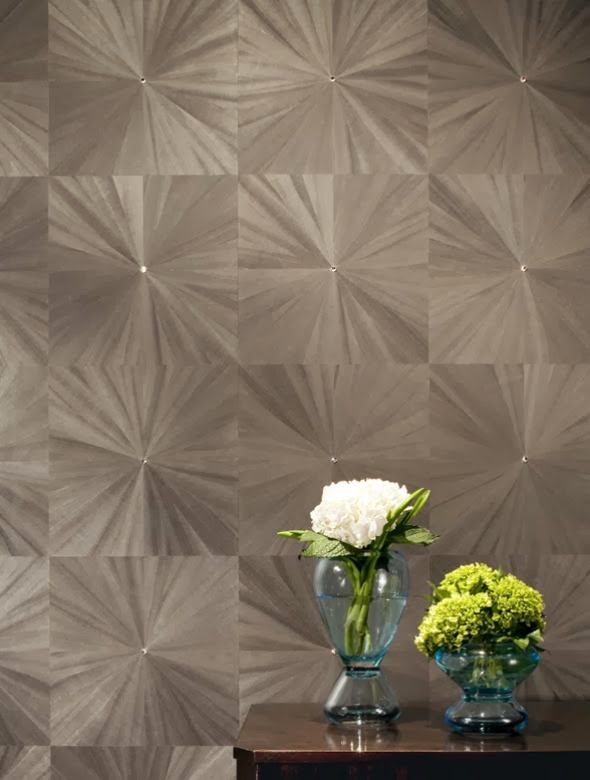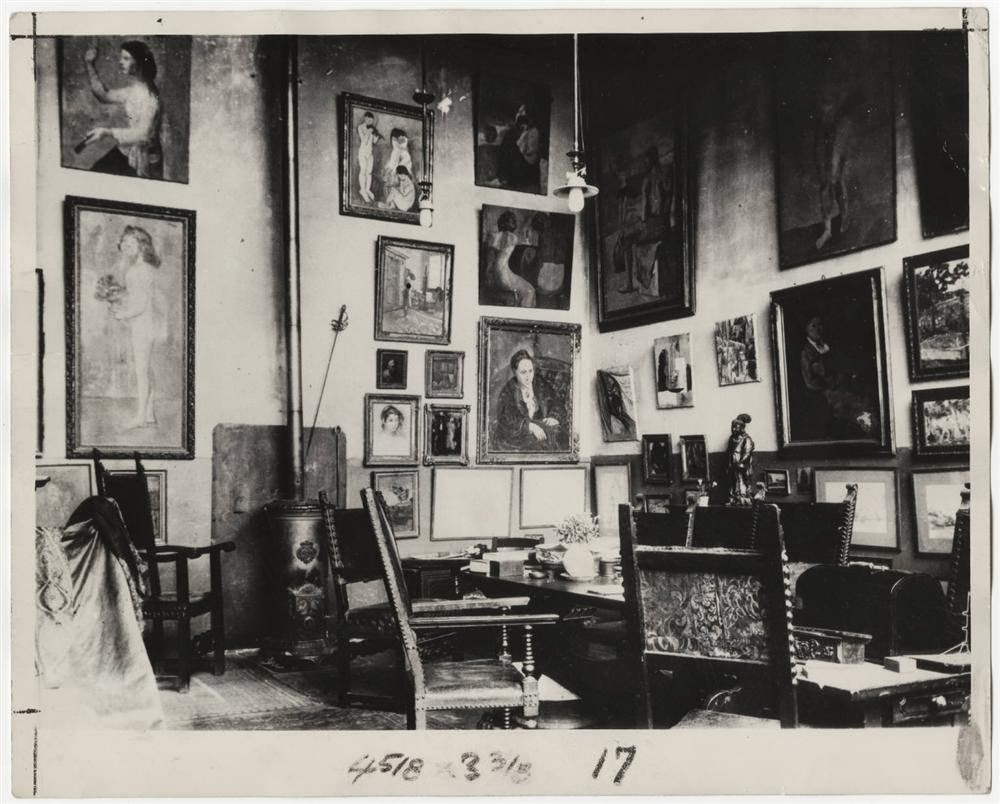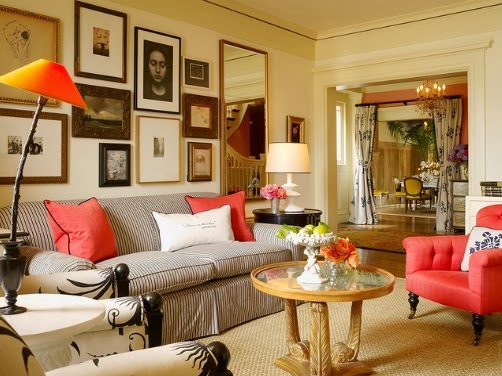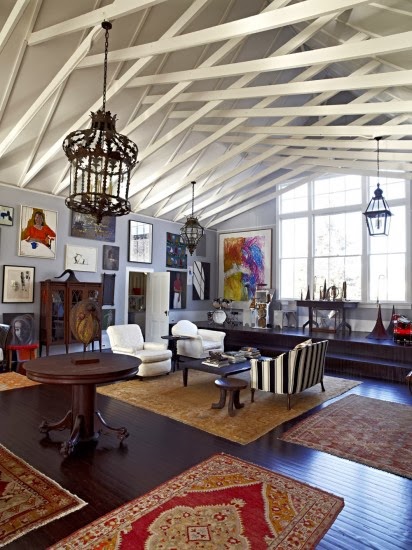When Richard Romanoff left UC Berkeley for an adventure in India in 1969, he came back with a new name: Maya. That same year, he attended the now-legendary music festival Woodstock where he became enamored of tie-dye as a fabric technique. All this laid the foundation for his eponymous company that produces wallcoverings and textiles.
At first, Maya Romanoff produced, naturally, tie-dyed fabric and wallpaper. But over the years, the company branched out into wallcoverings of all sorts. They are now known as a luxury brand, creating incredible works of art for walls for the likes of The Four Seasons and venerable British institution Harrod's.
In conjunction with interior designer Amy Lau, the company issued anniversary versions of a tie-dyed pattern in 2009. Below is the Snowflake pattern...
...and the tie-dyed pattern they call "Half Plaid!" I like the humorous reference of the name since it does indeed seem like a very loose interpretation of only the warp and not the weft of a woven fabric!
Here is a view of the tie-dyed wallpaper in the Amy Lau/Maya Romanoff pop-up store in Bergdorf Goodman. Honestly, if I did not know it was tie-dyed, it would simply read as some kind of fascinating texture like cork.
Perhaps Maya Romanoff is best known for their Beadazzled line: wallpaper--in a wide array of colors--covered with tiny glass beads, giving the paper a magical, glamorous appearance. I have seen this product in person and it is indeed beautiful but it is difficult for a camera to pick up the depth and sheen of the glass beads. Trust me when I say that in person, it is breathtaking.
The company makes wallcoverings from a variety of other exotic materials including thin veneers of actual Mother of Pearl which are flexible and can wrap around corners! It is available in different configurations such as an overlapping circle pattern or even in a chevron!
If you like the crisp, classic look of bespoke men's suits, you could clad your walls in Maya Romanoff's Blanket line of wool fabric wallcovering, available with different stitching options!
The Ajiro Sunburst line is made from wood veneer but it looks more like squares of ruched silk, gathered into a central point... which comes with an optional Swarovski crystal or pearl to embellish each panel (second image below)!
The company has introduced some new products recently and I really like the raised Croc pattern, and the wonderful visual texture of a line they call River Bed.
Unfortunately, Maya Romanoff passed away this year, on January 15th, 2014, of complications from Parkinson's. Thankfully, his visionary legacy continues with his company.
Maya Romanoff products are handmade by artists and craftspeople at the Romanoff factory in Ilinois.
http://www.mayaromanoff.com/
As I have said in past posts, when I dare to utter the word "wallpaper" to a client, I have been met with looks of horror, fueled by bad memories of 1960s or 70s wallpaper from childhood homes. But as you can see, Maya Romanoff makes a product that is amazingly chic, inventive, and artistic, which can enhance nearly any interior.
I'll be covering (pun intended) more wallpaper in future posts...stay tuned and happy designing!
Monday, April 28, 2014
Monday, April 21, 2014
Just For Fun: The Bed Nook
Remember how it felt when you were a kid and you snuggled into a fort you made from chairs, a blanket, and some pillows? Bed nooks seem like they would recreate that sensation beautifully!
And on a related and definitely lighthearted note, imagine having a fun evening with friends in these forts for grown-ups! I would love to invite 4 friends over for wine and talk in a fort like these!
Happy fort building!
Photo above by Emily Followill
And on a related and definitely lighthearted note, imagine having a fun evening with friends in these forts for grown-ups! I would love to invite 4 friends over for wine and talk in a fort like these!
Happy fort building!
Monday, April 14, 2014
Art, Salon Style
If you are like me, you love art. And if you are like me, you have a plethora of framed pieces and not enough wall space to display them all! But I have a solution which looks to the past for inspiration. American ex-pat author Gertrude Stein ran one of history's most famous--and talented--salons from her Paris apartment. She (along with her brother Leo) was an avid art collector, but was also a patron of a huge collection of famous artists, and was often gifted with works by said artists. So her walls became an ad hoc museum, with works by Matisse, Gauguin, Renoir, and Picasso grouped, squeezed and crowded together. Here is a photo of Stein's actual apartment at 27 rue de Fleurus, on the Left Bank.
I love how pieces which are hung salon-style speak to a kind of casual, bohemian, yet cultivated dedication to art. It is marvelously eclectic and affords an opportunity to introduce color, texture, and pattern into a room without making a permanent statement with something like a bold sofa or busy rug: the excitement comes from the walls. And the best part is, it can be changed and rotated as often as you wish!
The look can be cool and elegant such as this cohesive grouping below, all in similar tones and shades of neutral hues. The mismatched frames though, bring a bit of variety and a lovely, engaging tension.
But more often, a grouping exhibits the kind of serendipity and exuberance of an art connoisseur. (Photo by Marili Forastieri.)
I love the collection of 1940s and 50s oil portraits on the far wall in the living room of one of the guest houses at Ellen Degeneres and Portia de Rossi's former home. (Photo by Roger Davies.)
Then of course there is the effortless, casual sense of an embarrassment of riches...
When approached with a classical eye, it works in a bedroom suite as well.
If you are worried that too much on a wall will look heavy, look at this arrangement by Tamara Kaye Honey...it feels light and breezy.
And if you have a huge wall or large open space and don't know what to do with it, salon-style art can serve to cover a lot of acreage, and draw the eye upward, accenting wonderfully tall ceilings, as seen here in Kate and Andy Spade's Southampton Artist Colony by interior designer Steven Sclaroff. (Photo by Marili Forastieri.)
And finally, a salon-style collection does not have to be classic or traditional. Look at this playful, graphic Modernist collection, all in matching white frames, in this stark white bathroom!
If you have a large art collection, or if you are planning on collecting, consider hanging your pieces salon-style!
Happy designing!
I love how pieces which are hung salon-style speak to a kind of casual, bohemian, yet cultivated dedication to art. It is marvelously eclectic and affords an opportunity to introduce color, texture, and pattern into a room without making a permanent statement with something like a bold sofa or busy rug: the excitement comes from the walls. And the best part is, it can be changed and rotated as often as you wish!
The look can be cool and elegant such as this cohesive grouping below, all in similar tones and shades of neutral hues. The mismatched frames though, bring a bit of variety and a lovely, engaging tension.
But more often, a grouping exhibits the kind of serendipity and exuberance of an art connoisseur. (Photo by Marili Forastieri.)
I love the collection of 1940s and 50s oil portraits on the far wall in the living room of one of the guest houses at Ellen Degeneres and Portia de Rossi's former home. (Photo by Roger Davies.)
Then of course there is the effortless, casual sense of an embarrassment of riches...
When approached with a classical eye, it works in a bedroom suite as well.
If you are worried that too much on a wall will look heavy, look at this arrangement by Tamara Kaye Honey...it feels light and breezy.
And if you have a huge wall or large open space and don't know what to do with it, salon-style art can serve to cover a lot of acreage, and draw the eye upward, accenting wonderfully tall ceilings, as seen here in Kate and Andy Spade's Southampton Artist Colony by interior designer Steven Sclaroff. (Photo by Marili Forastieri.)
And finally, a salon-style collection does not have to be classic or traditional. Look at this playful, graphic Modernist collection, all in matching white frames, in this stark white bathroom!
If you have a large art collection, or if you are planning on collecting, consider hanging your pieces salon-style!
Happy designing!
Monday, April 7, 2014
Know Your Chairs: The Barcelona
Ludwig Mies van der Rohe was a legendary architect and one of the founders of Modernism. But aside from designing the structure, he often designed the furniture and furnishings that were to go in his buildings as well. Such is the case with what has come to be one of, if not the most famous chair designs in history: the Barcelona Chair.
In 1929, Mies (as he was referred to...sounds like Meez) was tapped to design the German Pavilion at the International Expo which was being hosted in Barcelona, Spain. This pavilion was to exemplify the new Weimar Republic, and according to the Commissioner of the Expo, Georg von Schnitzler, to give "voice to the spirit of a new era." So Mies designed a glorious building of steel, glass, travertine, marble, and red onyx. The result was a breathtaking space, spare, low, and radically new and utterly modern. It was not to house any trade exhibits but was to remain empty. The building itself was seen as the exhibit.
Mies designed some equally spectacular, minimalist furniture to occupy this radically minimalist space. The Barcelona chair was composed of tilted planes affixed to gracefully curved steel X legs below. The original chairs, along with their accompanying ottomans, were made of tufted ivory colored pig skin but subsequent versions were made of leather. The classic color now seems to be black, but can be made in white, black, or brown leather to fit with various color palettes. Although there are many unlicensed knockoffs and "versions" whose proportions are not quite right, the venerable modernist furniture manufacturer Knoll owns the rights to the authentic Barcelona Chair. Visit their site, http://www.knoll.com/, to order.
Without any forward thought or regard, the pavilion was destroyed in 1930, almost immediately after the Expo closed. But thankfully the structure was rebuilt between 1983 and 1986, using extant original plans and photographs as a guide, and is permanently on display at an alternate site in Barcelona. Visit the official site below for information about location and how to visit.
http://www.miesbcn.com/
The Barcelona chair compliments nearly any décor scheme from ethnic and eclectic to, of course, modern, whether mid-century or miminalist. You might find the Barcelona to be a good fit for your space.
Happy designing!
In 1929, Mies (as he was referred to...sounds like Meez) was tapped to design the German Pavilion at the International Expo which was being hosted in Barcelona, Spain. This pavilion was to exemplify the new Weimar Republic, and according to the Commissioner of the Expo, Georg von Schnitzler, to give "voice to the spirit of a new era." So Mies designed a glorious building of steel, glass, travertine, marble, and red onyx. The result was a breathtaking space, spare, low, and radically new and utterly modern. It was not to house any trade exhibits but was to remain empty. The building itself was seen as the exhibit.
Mies designed some equally spectacular, minimalist furniture to occupy this radically minimalist space. The Barcelona chair was composed of tilted planes affixed to gracefully curved steel X legs below. The original chairs, along with their accompanying ottomans, were made of tufted ivory colored pig skin but subsequent versions were made of leather. The classic color now seems to be black, but can be made in white, black, or brown leather to fit with various color palettes. Although there are many unlicensed knockoffs and "versions" whose proportions are not quite right, the venerable modernist furniture manufacturer Knoll owns the rights to the authentic Barcelona Chair. Visit their site, http://www.knoll.com/, to order.
Without any forward thought or regard, the pavilion was destroyed in 1930, almost immediately after the Expo closed. But thankfully the structure was rebuilt between 1983 and 1986, using extant original plans and photographs as a guide, and is permanently on display at an alternate site in Barcelona. Visit the official site below for information about location and how to visit.
http://www.miesbcn.com/
The Barcelona chair compliments nearly any décor scheme from ethnic and eclectic to, of course, modern, whether mid-century or miminalist. You might find the Barcelona to be a good fit for your space.
Happy designing!
Subscribe to:
Posts (Atom)














































